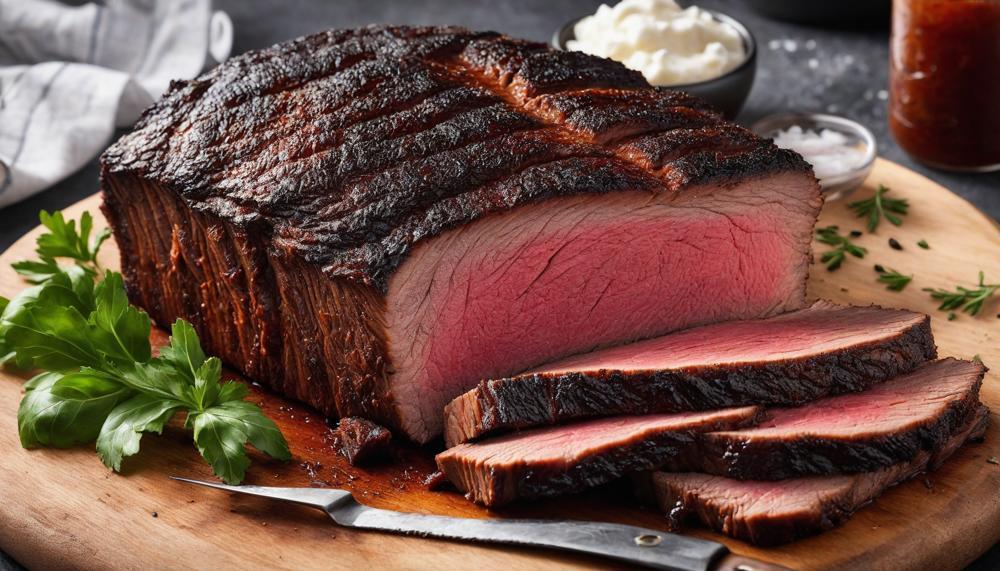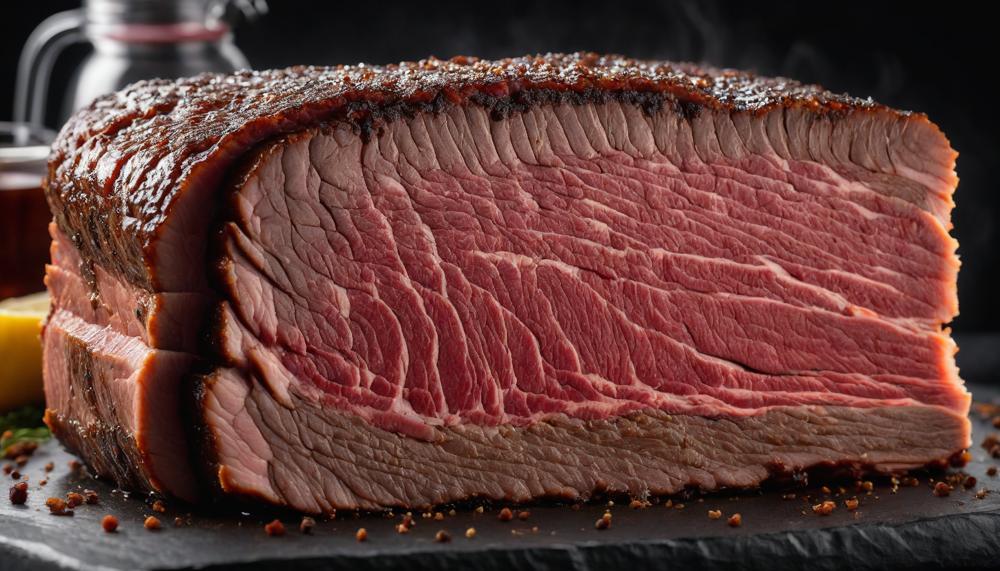Are you wondering how long you can keep that delicious smoked brisket in your refrigerator? Let’s dive right into it: properly stored smoked brisket can last up to four days in the fridge.
That’s enough time to enjoy those tender, smoky flavors without worrying about spoilage. But that’s just the beginning of the story.
Here are some key takeaways to keep in mind when storing smoked brisket:
- Storage Duration: Up to four days in the refrigerator.
- Freezing: It can be frozen indefinitely, but for best quality, aim to consume within two months.
- Immediate Storage: Refrigerate leftovers within two hours to maintain freshness and safety.
- Container Tips: Use shallow airtight containers or wrap tightly in plastic wrap and heavy-duty foil.
- Temperature Control: Ensure your fridge is set between 35-40°F for optimal storage.
- Gravy Consideration: Brisket with gravy typically lasts about two days in the fridge compared to four days without.
- Creative Uses: Explore different recipes to enjoy your brisket within the recommended timeframe.
- Freezing Leftovers: If you can’t finish it within four days, freeze it promptly for future enjoyment.
Now that you know the basics, you can savor every last bite of that smoky goodness knowing it’s safely stored and ready for your next meal. Happy brisket storing.
Contents
How Long Does Smoked Brisket Last?
| Storage Method | Duration | Additional Tips |
| Refrigerator (35-40°F) | Up to 4 days | – Store in shallow, airtight containers or wrap tightly in plastic wrap and heavy-duty aluminum foil. – Refrigerate leftovers within 2 hours of cooking to prevent bacterial growth. – Brisket with gravy or sauce lasts about 2 days in the fridge. |
| Freezer (0°F or below) | Up to 2 months for best quality | – Freeze in portions for easy reheating. – Thaw overnight in the refrigerator before reheating. – Use freezer-safe bags or containers. |

How To Store Smoked Brisket
To store smoked brisket and keep it fresh, follow these essential steps:
- Resting the Brisket: Allow the brisket to rest until it reaches around 0°F before storing it in the fridge.
- Air-tight Storage: Use air-tight containers or wrap the brisket tightly in plastic wrap and heavy-duty foil to prevent air exposure, which can dry out the meat.
- Refrigeration: Store the brisket in the coldest part of your refrigerator, ideally between 35-40°F (1.7-4.4°C), to maintain freshness.
- Duration in Fridge: When stored correctly, smoked brisket stays fresh for up to four days in the refrigerator.
- Freezing Method: For longer storage, freeze the brisket. Here’s how:
| 1. | Cut into Portions | Cut brisket into portions or slices. |
| 2. | Layer for Freezing | Arrange slices in a single layer on a parchment-lined baking sheet. |
| 3. | Initial Freeze | Freeze for a few hours until slices are solid. |
| 4. | Final Packaging | Transfer frozen slices into freezer bags or airtight containers for up to two months. |
How Long Does Smoked Brisket Last in the Refrigerator?
Smoked brisket typically lasts up to four days in the refrigerator when stored correctly in air-tight containers or tightly wrapped. For extended storage, consider freezing it.
Smoked brisket, a tender and flavourful cut of beef, retains its quality for about four days in the refrigerator if properly stored. This involves sealing it tightly in containers or wrapping it securely to prevent air exposure, which can lead to quicker spoilage.
To maintain its freshness beyond four days, freezing is recommended. Initially, slice the brisket and place it on a baking sheet to freeze. Once frozen, transfer the slices into freezer bags or vacuum-sealed pouches. When frozen properly, brisket can last up to two months without significant loss of quality.
Proper storage practices are crucial to preserving smoked brisket. By following these guidelines, you can enjoy your smoked brisket for longer periods, ensuring each serving is as delicious as the last.
| Storage Method | Refrigerator | Freezer |
| Duration | Up to 4 days | Up to 2 months |
| Preparation | Store in air-tight containers or tightly wrapped | Slice, freeze on a baking sheet, then transfer to freezer bags |
Can You Freeze Leftover Brisket?
| Can You Freeze Leftover Brisket? | Yes, you can freeze leftover brisket. | |
| How to Freeze Brisket |
To preserve leftover brisket for future meals, follow these steps:
|
 |
| Thawing and Reheating |
To thaw brisket, move it from the freezer to the refrigerator the night before use. For faster thawing, place the sealed bag in cold water until thawed. When reheating, wrap the brisket in foil to retain moisture and bake it in the oven at a low temperature or gently warm it in a skillet with a bit of broth. |
 |
| Storage Duration |
Frozen brisket can be kept for up to three months. Beyond this period, the quality may degrade. Ensure proper wrapping and avoid refreezing thawed brisket to maintain optimal taste and texture. |
Yes, you can freeze leftover brisket. To preserve it for future meals, slice the brisket, freeze the slices on a baking sheet, then transfer them to a freezer-safe bag or container. Thaw in the fridge overnight or use the cold water method for quicker thawing. Reheat gently wrapped in foil to retain moisture.
Thawing Tips
| Best Ways to Thaw Smoked Brisket Safely | Explanation | Key Points |
| Refrigerator Thawing | Safest method for preserving flavour, tenderness, and texture of smoked brisket. |
|
| Cold Water Thawing | Faster alternative to refrigerator thawing, requires more monitoring. |
|
| Microwave Thawing | Not recommended due to risk of uneven thawing and texture damage. |
|
| Unsafe Methods | Avoid counter and hot water thawing to prevent bacterial growth. |
|
| Additional Considerations | Ensure quality and safety when freezing, reheating, and storing brisket. |
|
By following these methods, you can safely thaw smoked brisket while preserving its quality and avoiding foodborne risks. Each method offers distinct advantages depending on your timeframe and preparation needs.
How To Reheat Thawed Brisket
| Method | Description | Key Points |
| Oven Method | Preheat oven to 225°F (110°C). Wrap brisket tightly in foil to retain moisture. Place on a baking tray and heat until internal temperature reaches 140°F (60°C). | Ensures even heating and minimal moisture loss. |
| Microwave Method | Place brisket in a microwave-safe dish. Loosely cover to allow steam to escape. Microwave at 20% power until gently warmed. | Quick option; prevent drying by low-power settings. |
| Sous Vide Method | Vacuum-seal brisket and submerge in 160°F (70°C) water for up to 1 hour. Ensures even reheating without overcooking. | Precise temperature control retains moisture. |
| Crockpot Method | Place brisket in crockpot with juices. Set on low heat (185-200°F or 85-95°C) for 4 hours until internal temperature reaches 165°F (75°C). | Slow, gentle heating preserves tenderness. |
| Reheating Sliced Brisket | Keep brisket whole if possible to retain juices. Slice after reheating to maintain moisture. | Enhances flavour by allowing meat to reabsorb juices. |
By following these methods, you ensure that your reheated brisket remains as delicious and moist as when it was freshly cooked.
How To Tell If Brisket Has Gone Bad
| Signs of Spoilage | Description | Action Needed |
| Foul Odor | If the brisket smells sweet, sour, or like rotten eggs, it indicates spoilage due to bacterial growth. | Discard the brisket immediately to avoid foodborne illness. |
| Texture Changes | Check for a slimy or overly dry texture, which are signs that the meat has gone bad. | Do not consume and dispose of the brisket to prevent health risks. |
| Appearance | Look for any unusual discoloration, particularly green or white patches, indicating mold growth. | Throw away the brisket as consuming mold can lead to serious health issues. |
Conclusion
When it comes to enjoying that mouthwatering smoked brisket, proper storage is key to preserving its delicious flavors. As highlighted in our exploration, smoked brisket can typically be kept in the refrigerator for up to four days when stored correctly. This timeframe allows you to savor every tender bite without concerns about freshness.
For optimal storage, ensure your brisket is promptly refrigerated within two hours of cooking to prevent bacterial growth. Use shallow, airtight containers or wrap it tightly in plastic wrap and heavy-duty foil to maintain its moisture and quality. Remember, brisket with gravy or sauce may have a shorter shelf life of about two days due to the added moisture content.
If you find yourself unable to finish your brisket within four days, freezing is a great option. Frozen brisket can maintain its quality for up to two months, provided it’s properly packaged and stored.
By following these storage guidelines, you can extend the enjoyment of your smoked brisket, ensuring each serving is as delectable as the first. Whether you’re planning your next meal or saving leftovers for later, these tips will help you make the most of your culinary experience.






